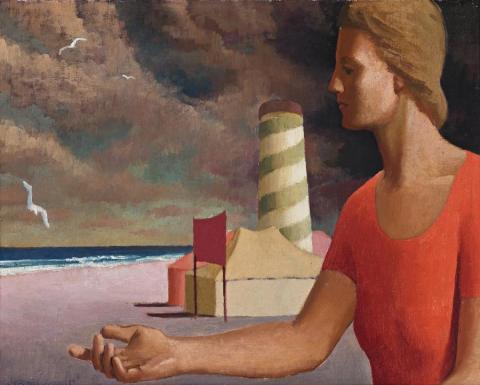FEEDING THE SEAGULLS, 1955
Jeffrey Smart
oil on canvas on board
29.5 x 36.5 cm
signed lower left: JEFFREY SMART
Macquarie Galleries, Sydney
Private collection, Melbourne
Jeffrey Smart, Macquarie Galleries, Sydney, 24 August - 5 September 1955, cat. 8
Cook, J., 'Voice of the artist heard', Daily Telegraph, 24 August 1955, p. 4
Quartermaine, P., Jeffrey Smart, Gryphon Books Pty Ltd, Melbourne, 1983, p. 105, cat. 286
Feeding the Seagulls has all the elements that comprise the classic Jeffrey Smart painting - excellence of execution, stillness, balanced composition, and a mood of expectation. The main difference between this painting and his later works is the large figure clad in red, placed close up against the picture plane. In the development of his art, the figure became pictorially less important, reduced in size, though placed in key positions within the compositions. Greater objectivity was achieved by putting, as it were, things at arm's length. Smart has often remarked that he introduced figures to give his compositions scale. Referring to his 1962 painting The Cahill Expressway in the collection of the National Gallery of Victoria, Smart said: 'The truth is I put figures in mainly for scale, the way Corbusier always drew a figure besides his buildings.' Then cautioned, 'You have to be very careful because as soon as you put a figure in a painting the viewer's eye goes straight to it, like a magnet. So I try not to make them too interesting; they are never beautiful or sexy.'1 However, whatever protestations he may make, seldom does any object or detail in a Smart painting have a merely pictorial role. Significantly, in 2001 Smart wrote: 'The most difficult, most challenging thing to draw is the glorious human body. If an artist cannot draw this, then he must paint landscapes or still life, where his deficiencies will not be noticed... But once the artist has mastered drawing the human body, he can draw whatever he pleases.'2
In Feeding the Seagulls and other paintings of this time Smart proved that he could draw and paint the human figure - with his customary consummate skill. Here the dominance of the female figure, neo-classical of pose and profile, performs a special role. Her gesture is more one of introduction than that of casting food across the sands for birds. Again, this is typically Smart, the enigmatic never being too far from the surface. Posed figure and canvas shelters express alike the artifice of theatre, hinting at what is about to unfold, as do the darkly gathering clouds. Exquisite colours seduce the eye; and the green and white striped tower hints at those road signs of the autostrada to come. Included in his 1955 solo exhibition at Sydney's Macquarie Galleries, many of the paintings had a beach location - Evening, Bondi, Lovers by the Sea, and Figures on the Beach. Interest in things industrial was also present in Kurnell, 1955, now in Wesfarmers Art Collection. While Feeding the Seagulls shows Smart's early mastery of realism, he used it for no mere likeness, rather, to create that surreal moment when art supersedes reality.
1. Smart, J., quoted in Capon, E., Jeffrey Smart Retrospective, Art Gallery of New South Wales, Sydney, 1999, p. 92
2. Smart, J., 'On Drawing', Jeffrey Smart Exhibition of Drawings, Watercolours & Studies, Philip Bacon Galleries, Brisbane, 2003, no pagination
DAVID THOMAS
